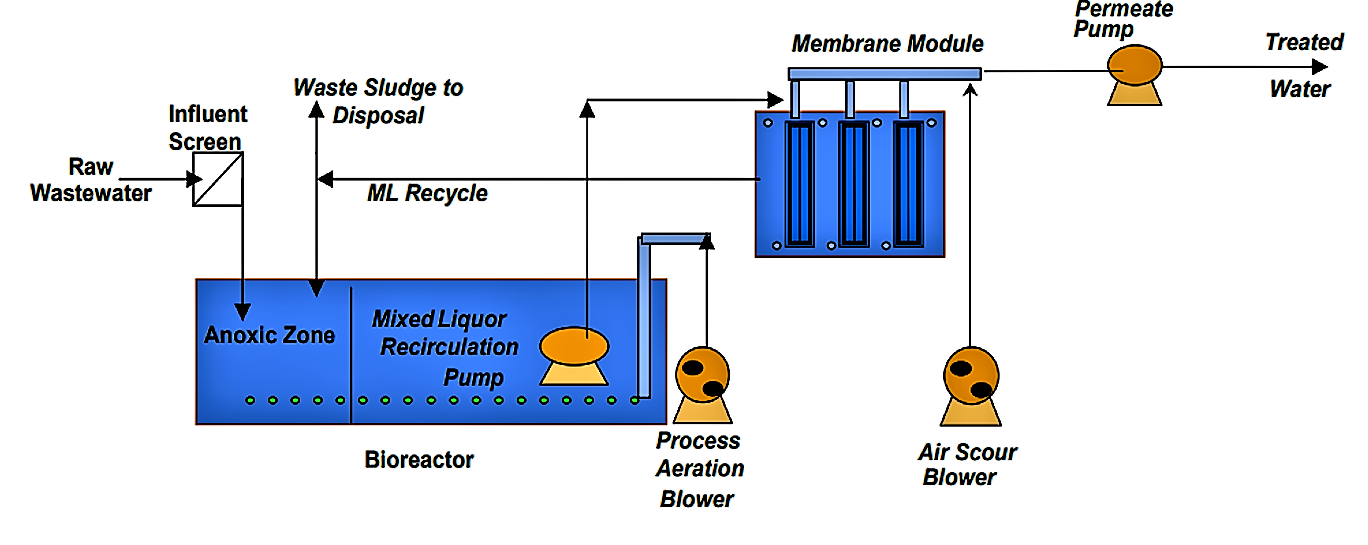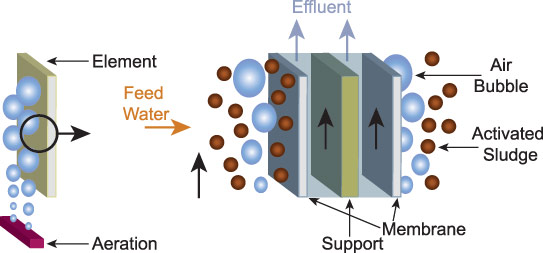The Science Behind Membrane Bioreactor: How It Works and Why It’s Effective
The Science Behind Membrane Bioreactor: How It Works and Why It’s Effective
Blog Article
The Advantages of Membrane Bioreactors in Sustainable Wastewater Monitoring
Membrane layer bioreactors (MBRs) stand for a pivotal development in lasting wastewater management, successfully merging organic treatment with innovative membrane filtration modern technology. This assimilation not only improves effluent high quality by efficiently getting rid of pollutants yet likewise opens methods for water reuse in various applications, therefore addressing journalism requirement for source conservation. Moreover, the compact layout of MBRs adds to considerable decreases in ecological impact and functional prices. As the need for lasting services intensifies, checking out the diverse benefits of MBRs might disclose unanticipated implications for the future of wastewater treatment systems.
Overview of Membrane Bioreactors
Membrane layer bioreactors (MBRs) represent a significant development in wastewater treatment technology, integrating organic destruction with membrane layer filtering to improve the performance of the therapy process. This innovative system combines the benefits of conventional turned on sludge procedures with membrane technology, permitting enhanced solid-liquid separation. MBRs make use of semi-permeable membranes to different treated water from biomass, resulting in premium effluent that can be recycled or safely released right into the atmosphere.
The operational layout of MBRs commonly includes a bioreactor where microorganisms damage down natural matter, followed by a membrane layer unit that filterings system the blended liquor. This arrangement not only minimizes the impact of the treatment center but also permits higher biomass focus and minimized hydraulic retention times. Moreover, MBRs are capable of dealing with a wider series of pollutants, consisting of nutrients and pathogens, making them appropriate for numerous applications, from municipal wastewater treatment to industrial effluent processing.
The assimilation of MBRs into wastewater monitoring systems is indicative of a growing pattern towards sustainable and reliable practices in environmental engineering. Their capability to produce high-quality effluent while reducing room requirements settings MBR modern technology as a principal in modern-day wastewater treatment services.
Improved Effluent High Quality

The membrane layer filtering procedure functions as a physical obstacle, allowing the retention of bacteria and particulate matter, which adds to a clearer and cleaner effluent (Membrane Bioreactor). MBRs run at higher biomass concentrations than standard activated sludge systems, promoting more effective biodegradation of toxins. This results in a decrease in biochemical oxygen need (BOD) and overall put on hold solids (TSS) levels in the final effluent
In addition, MBRs demonstrate exceptional efficiency in dealing with tough wastewater structures, such as commercial effluents and wastewater with high nutrient lots. Consequently, the effluent produced is usually of better, permitting even more adaptable disposal options and minimized ecological influence. Eventually, the improved effluent high quality accomplished through MBR innovation emphasizes its vital function in progressing lasting wastewater management practices.
Water Reuse Opportunities
The premium effluent created by membrane bioreactors (MBRs) opens up significant possibilities for water reuse in numerous applications. MBRs efficiently eliminate pollutants, including microorganisms, suspended solids, and natural issue, causing cured water that satisfies or goes beyond regulatory standards for reuse. This quality enables the execution of water reusing initiatives throughout varied industries.
One noticeable application remains in farming, where dealt with wastewater can be used for irrigation, advertising lasting farming methods while conserving freshwater sources. Furthermore, MBR-treated effluent can be utilized for industrial processes such as air conditioning, cleansing, and as a process water resource, considerably minimizing the demand for potable water in these procedures.
In metropolitan atmospheres, MBRs facilitate making use of reclaimed water for landscape irrigation, commode flushing, and other non-potable uses, adding to the general strength of water system systems. The combination of MBR innovation in decentralized systems aids in taking care of localized water needs, especially in water-scarce regions.
Minimized Ecological Influence
Just how can the adoption of membrane layer bioreactors (MBRs) contribute to a decreased environmental effect in wastewater management? MBRs considerably boost the treatment effectiveness of wastewater while reducing eco-friendly disturbances. Membrane Bioreactor.
In addition, MBRs operate at reduced hydraulic retention times compared to standard systems, resulting in smaller therapy plant footprints. This small design decreases land usage, thereby protecting all-natural habitats and biodiversity. The process additionally generates less sludge than typical methods, minimizing disposal challenges and reducing greenhouse gas exhausts connected with sludge management.
Furthermore, MBRs promote the recovery of important sources, such as water and nutrients, adding to a round economy. By allowing water reuse for watering or commercial processes, MBRs help relieve freshwater shortage, therefore advertising lasting water make use of techniques. Ultimately, the adoption of MBR innovation represents a considerable stride in the direction of lessening the ecological impact of wastewater management systems.
Economic Advantages of MBRs

Furthermore, MBRs help with the production of premium effluent, which can be recycled for different applications, such as agricultural irrigation and industrial procedures - Membrane Bioreactor. This reuse capacity can dramatically lower water procurement expenses, supplying a monetary incentive for industries encountering rigid water laws
The portable style of MBR systems likewise results in lowered land demands, which is especially important in urban locations where realty is expensive. By reducing room, districts and markets can conserve on land purchase and upkeep costs.
Furthermore, MBRs frequently call for less frequent maintenance and have a longer life-span than standard systems, even more adding to cost savings. In summary, the financial benefits of MBRs-- varying from minimized operational prices to land cost savings and effluent reuse-- make them an engaging option for lasting wastewater administration, providing both long-term and instant financial advantages.
Final Thought
Membrane layer bioreactors stand for a transformative strategy to lasting wastewater click here for more administration, incorporating biological treatment with innovative membrane layer filtration for remarkable effluent quality. Their capability for reliable impurity removal helps with water reuse, consequently conserving important freshwater resources. In addition, MBRs add to reduced ecological impacts through small styles and reduced sludge generation. Economic benefits better enhance their practicality, making MBRs an appealing remedy for addressing the challenges of wastewater therapy and promoting sustainable resource management.
Membrane bioreactors (MBRs) represent a crucial advancement in lasting wastewater management, efficiently merging biological treatment with sophisticated membrane filtration technology.Membrane bioreactors (MBRs) represent a considerable innovation in wastewater therapy modern technology, incorporating organic degradation with membrane layer filtering to improve the performance of the treatment process.Accomplishing enhanced effluent high quality is one of the most substantial benefits of utilizing membrane layer visit this website bioreactors (MBRs) in wastewater treatment.Additionally, MBRs show superb efficiency in dealing with challenging wastewater compositions, such as commercial effluents and wastewater with high nutrient tons.Integrating membrane bioreactors (MBRs) right into wastewater administration not just lowers environmental influence however also offers considerable economic benefits.
Report this page